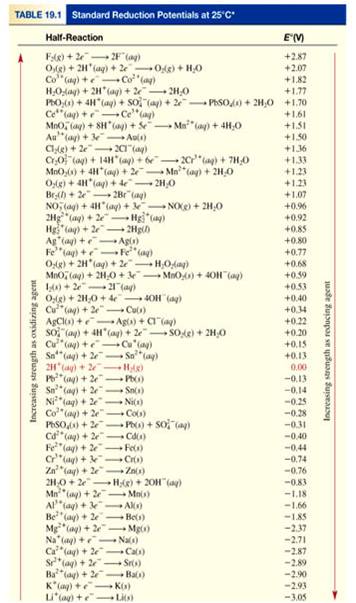Electrochemistry
Charge ( Q ) = Current ( I ) × time ( t )
- Faraday's Laws Of Electrolysis.
One mole of electric charge (96,500 coulombs), when passed through a cell, will discharge half a mole of a divalent metal ion such as Cu2+. This relation was first formulated by Faraday in 1832 in the form of two laws of electrolysis:The weights of substances...
- Galvanic Cells
This arrangement is called a Galvanic cell. A typical cell might consist of two pieces of metal, one zinc and the other copper, each immersed each in a solution containing a dissolved salt of the corresponding metal. The two...
- Electrochemistry : 10.2 Nernst Equation
NERNST EQUATION Cell potential (E°cell) under any condition Ecell = E°cell – (RT/nF) ln Q R: universal gas constant. Q...
- Thermochemistry : 9.3 Born-haber Cycle
First Ionization Energy (IE1)Energy required for 1 mol of gaseous atom to lose 1 mol of electrons. Affinity Electron (EA) Energy change that occurs when 1 mol of gaseous atom gains 1 mol of electrons. Lattice EnergyEnergy change when 1 mol of solid...
- Group Member Of This Blog
Group 1 ~Thermochemistry~ Group Leader : Khor Sheng Yau Muhammad Amirul Syafiq Bin Azudin ...
Electrochemistry
Faraday law
FARADAY LAW
- Amount of substance produce of each electrode is directly proportional to quantity of charge flowing through the cell
- Also called Faraday's First Law of electrolysis.
CALCULATING USING FARADAY'S LAW
- Main steps
- Balance half reaction to find number of moles of electrons.
- Needed per mole product.
- Use Faraday's constant (96500C / mol ) to find corresponding charge.
- Use molar mass / mole to find charge needed for a given mass / mole of product
ELECTRIC CHARGE (Q)
Charge ( Q ) = Current ( I ) × time ( t )
Unit Coulomb , C Ampere , A Second , s


- Faraday's Laws Of Electrolysis.
One mole of electric charge (96,500 coulombs), when passed through a cell, will discharge half a mole of a divalent metal ion such as Cu2+. This relation was first formulated by Faraday in 1832 in the form of two laws of electrolysis:The weights of substances...
- Galvanic Cells
This arrangement is called a Galvanic cell. A typical cell might consist of two pieces of metal, one zinc and the other copper, each immersed each in a solution containing a dissolved salt of the corresponding metal. The two...
- Electrochemistry : 10.2 Nernst Equation
NERNST EQUATION Cell potential (E°cell) under any condition Ecell = E°cell – (RT/nF) ln Q R: universal gas constant. Q...
- Thermochemistry : 9.3 Born-haber Cycle
First Ionization Energy (IE1)Energy required for 1 mol of gaseous atom to lose 1 mol of electrons. Affinity Electron (EA) Energy change that occurs when 1 mol of gaseous atom gains 1 mol of electrons. Lattice EnergyEnergy change when 1 mol of solid...
- Group Member Of This Blog
Group 1 ~Thermochemistry~ Group Leader : Khor Sheng Yau Muhammad Amirul Syafiq Bin Azudin ...
